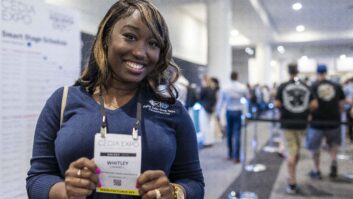For those of you that opted not to come to San Diego for CEDIA this year I say this: I’m sorry. This city has been a terrific backdrop for what is my favorite tradeshow of the year, and it has been absolutely terrific for the three days I’ve been here so far. The weather fluctuates about 2 degrees, hovering between a perfect 74 and an also perfect 76, with clear blue skies and virtually zero humidity. Add in a terrific craft beer and local food scene, ocean front views of aircraft carriers and luxury yachts, and a downtown baseball stadium, and you have the makings of a terrific host city! But enough about San Diego, let’s rundown some of the best things I’ve come across at CEDIA after day one!
Modus VR

Last year this was demonstrated as a proof of concept between REAL Audio Video and Fractal Mob; a way of showing how virtual reality could be used as a high-end sales and presentation tool. Over the past year, they have tweaked and improved the software, reducing the time it takes to design a space down from a few months to just a few minutes. Pop clients into a virtual space and design a room from the ground up right around them. Drag in columns and risers and adjust seating locations and screen sizes. Customers can now perfectly visualize what a 100- or 150-inch screen will look like from a given distance. The company is now called Modus VR and they are at CEDIA looking to sell this technology to integrators so they can use the tool to help in their own system designs.
Origin

Jeremy Burkhardt Sometimes the simplest ideas are the best, and the idea for Origin Acoustic’s Valet amplifier came while out hiking in the mountains. The idea is to install multiple Amazon Dots throughout a home in the ceiling in speaker frames and covered with speaker grilles so they totally disappear into the room. These dots then wire back via Category cabling to an Origin Acoustics Valet amplifier creating a multi-zone audio system that is totally voice controlled. Origin’s CEO, Jeremy Burkhardt, said he feels Alexa will be even bigger for the channel than the iPod, and that the opportunity to get on board and embrace this technology already loved by millions – and supported by a thousand engineers at Amazon – is huge and shouldn’t be missed. “Some will see [Valet] as an amplifier; others will see it as an opportunity.” Regardless, it is another really forward-thinking idea from a company known for innovation in the channel.
Samsung Frame

I had heard about the new Samsung Frame TV prior to CEDIA but never actually viewed one in person, and I have to say it is another one of those simple, “Wow!” ideas when viewed in real life. This is another stupid-simple idea: make a TV look like a work of art when not in use. The Frame has a black art-like bezel that surrounds the screen that can be replaced with an optional white or wood colored trim. The user can then select from a variety of pre-loaded high-quality art pieces (or supply their own from a smart phone) and can then select from a variety of matte styles and colors. Customers can even tweak the color temperature and light levels to suite their room and environment, and the set has timers to automatically shut off in the evening hours. The result is something that completely blends into the environment. How good does it look? I found myself walking around the booth and pointing to sets hanging amidst artwork and asking, “TV or art?” For customers wanting a large 4K Ultra HD smart TV without the look of one, the Frame is an amazing solution.
Sony 4K

For me, this might be the most exciting news out of the show; Sony announced a brand new, sub-$5,000 4K projector. This is an amazing point of entry for the front projector market, and I think will lead to mass adoption of 4K front projection. But how does it look? Sony demonstrated the projector in its booth on a 160-inch diagonal screen, and the image was incredibly bright and detailed, with a ton of punchy colors. On a more real-world sized screen, I think this is going to look awesome. So much so, that my company pre-ordered two of them! Sony launched two other 4K front projectors at the show including a new $25,000 laser projector that looked amazing. To further drive 4K projector sales and content adoption, Sony announced a strategic partnership with Kaleidescape, where customers that purchase a new 4K Sony projector and own a Kaleidescape Strato movie server will be eligible for 10 4K movie download credits worth up to $350 from the Kaleidescape movie store.
Kaleidescape

Speaking of Kaleidescape, besides showing off its new Co-Star switch (reviewed here) the company “teased” an advanced look up an upcoming beta release of its kOs software which will allow users to navigate the movie store and purchase movies directly from the on-screen user interface. You can browse through collections, new releases, by actor, by director, and by similar films, all with an experience that feels very similar to navigating the cover art movie collection screen. This will make it much easier to easily add films to a collection. No announcement on when this feature would be enabled.
Marantz

Marantz showed off several new products including a new pre-pro (the AV7704) and a new beast of a receiver, the SR-8012. This receiver will be the company’s first to feature a full 11 channels of power amplification on board, capable of processing and driving a full 7.2.4 surround system without needing any additional amplification. Lifting this monster proved it features a serious power supply and construction, and the unit pictured here with a clear top shows the internal construction. This will be the highest performing AVR Marantz has produced in years, and will retail for around $3,000. Select Marantz and Denon receiver models this year will also include Auro-3D (review of that technology here) out of the box without requiring the optional $199 upgrade.
Definitive Demand

Definitive Technology has completely reworked its Studio Monitor bookshelf line-up with the new Demand Series. There are three speakers in the line-up, and all feature totally new designs with technology borrowed from the company’s flagship BP-9080 towers. The speakers produced a surprising amount of bass, and could easily deliver high-performance two-channel listening without needing a subwoofer. The speakers also feature a striking modern design, with a detachable magnetic grille and new optional speaker stands with matching cosmetics. To maximize imaging and soundstage, the tweeters are positioned differently on the left and right speakers, and they will be shipped in pairs with speakers labeled Left and Right on the back.
Deako

Deako is a new company I discovered in Innovation Alley that has a remarkable rethink to how smart lighting systems are installed. The company has designed a “back box” that wires and installs inside a regular high-voltage wall box that allows you to snap new switches in and out safely and quickly without the need to cut a breaker. Swapping out an old switch for a new one takes less than 10 seconds and the new switch is immediately up and working. The idea is to have the builder/electrician trim the house with the company’s “dumb” switches that retail for $20 (including back box). When the homeowner moves in and wants to automate the lighting, these dumb switches are popped out and smart switches ($80) or dimmers ($100) are installed in their place. Instead of hours or days, this process would take minutes. Each smart device can also be programmed with three presets, and the system includes a nice app for controlling the system and setting up advanced scenes and scheduled events. Oh, and with the optional Wi-Fi Bridge ($99) the system works with Google Home and Amazon Alexa. Definitely something worth checking out!
JBL

One of my favorite demos every year is at the JBL Synthesis surround demo at the Harman booth, and this year’s definitely did not disappoint! This custom-built theater housed over 30-speakers totally concealed behind fabric, paneling and the massive screen, producing a $250,000-plus audio system that was absolutely stunning. The first demo was the opening scene from Guardians of the Galaxy 2, but they used the non-Atmos track, instead upmixing the audio using Auro-3D for an incredibly natural and enveloping experience. The second demo was 4K content from Passengers and utilized the near 30-channels of audio for a completely immersive experience. Bass was tight and hammered you in the chest but never felt boomy or over driven, and even at high SPL the audio never strained or sounded fatiguing.
Control4

Control4 had a ton of new announcements built around the launch of the company’s latest OS improvement, version 2.10. This free update packs in a load of requested new features including improved announcements (which can now be up to 30 seconds in length and in any audio format the system supports, including high-res), a new Intercom app for two-way communication between the home (either a doorstation or touchscreen) and smart phone, the addition of iHeartRadio and Spotify music services, new camera viewing features, “Else” programming, and more. One of the biggest new features is actually on the user-side of the system with something the company calls “When >> Then Automation.” This allows users to go in and fine tune their systems after the installer has finished the setup so they can tweak events to their preference. These will be things like “When I press this button on a keypad, Then play this music station.” Or “When it is sunset, Then turn on these outside lights.” The customer can’t alter or change any of the dealer programming, and the user changes are visible to the dealer so they can edit, fix (or delete) anything the customer has done that might mess up the system. Oh, and a constant backup of the user’s project is stored in the cloud in case they really botch something and need a full “do over.”
Golden Ear

My final demo of the first day was at the Golden Ear Technologies booth, where CEO Sandy Gross gave me a lengthy audition of the company’s new Invisa Signature Point Source in-wall speaker. The new speaker was used in an L/C/R array, and features four 5 ¼-inch cask basket drivers very similar to those used in the Triton One towers, along with a full size High Velocity Folded Ribbon tweeter. The smart design allows installers to rotate the tweeter pod as needed for use in a horizontal positioning. To achieve a point source radiation pattern, the four drivers aren’t the same and don’t cover the same frequency range, being carefully tailored to deliver the optimal crossover points. While Sandy prefers the speaker to be installed solo in a wall for best sound, they do offer an optional backbox if audio leaking into an adjoining room is an issue. Sandy said he wanted to demo a more “real world’ audio system at this show, and the 5.2.4 system demonstrated would retail for a very respectable $8500. Besides the three Point Source front, the demo included four Invisa 7000 in-ceiling height channels, two MPX in-wall rear channels, and two Super Sub X subs rounding out the low end. Rest assured, the system, while affordable, still punched well above its weight class, producing audio that sounded natural and breathy. The system was really just easy and, frankly, enjoyable to listen to. I was repeatedly awed by the subtle detail the speakers produced, with delicate creaks and groans and the strains of a ship from a Game of Thrones demo clearly audible, amidst the cacophony of battle. I was also more aware of small details like the way the bow springs strained, where you could hear the tension of the strings as the archers held their arrows. The localization was also spot on, letting you pinpoint each detail of the on-screen audio. Watching Everest in Atmos produced a blizzard of snow that blanketed the room, pelting the walls and ceiling with ice and snow and swirling winds, however dialog remained clear and locked up front. When Sandy switched to music, the Point Source speakers made it clear they were equally at home with music, producing an impressively wide and massive soundstage, with audio spreading well beyond the width of the front channels. One thing that really struck me was the detail and the decay of instruments, where you could listen to the sounds of bells and cymbal strikes tapering off into nothingness. With the Signature Point Source Golden Ear has once again delivered on its promise of high-end audio at real world pricing.







